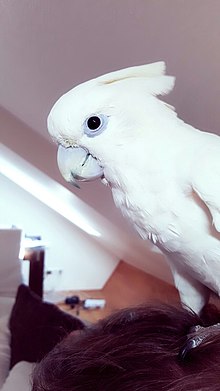| Solomons corella | |
|---|---|

| |
| Conservation status | |
 Least Concern (IUCN 3.1) | |
| Scientific classification | |
| Domain: | Eukaryota |
| Kingdom: | Animalia |
| Phylum: | Chordata |
| Class: | Aves |
| Order: | Psittaciformes |
| Family: | Cacatuidae |
| Genus: | Cacatua |
| Subgenus: | Licmetis |
| Species: | C. ducorpsii |
| Binomial name | |
| Cacatua ducorpsii Pucheran, 1853 | |
| Synonyms | |
|
Cacatua tanimberensis Roselaar & Prins,
2000 | |
The Solomons corella (Cacatua ducorpsii), also known as Solomons cockatoo, Ducorps's cockatoo or broad-crested corella, is a species of cockatoo endemic to the Solomon Islands archipelago. This small white cockatoo is larger than the Tanimbar corella yet smaller than the umbrella cockatoo. The species is common across most of the Solomons, absent only from Makira in the south. It inhabits lowland rainforests, secondary forests, cleared areas and gardens.
Description
The Solomons corella is about 30 cm (12 in) long. They are predominantly white. They have a blue eye ring and a recumbent crest which resembles a sail in its raised state. As other members of the subgenus Licmetis, it has a pale bill.
Distribution & population
The Solomons corella is abundant on all islands in the archipelago except Makira and surrounding islands. Ornithologists estimate that the bird has a population of around 100,000 individual birds. It has been listed as Least Concern by the International Union for Conservation of Nature.

Breeding
The Solomons corella nests in tree cavities. The eggs are white and there are usually two in a clutch. The eggs are incubated for about 25 days and the chicks leave the nest about 62 days after hatching. Wild birds typically breed from July–September.
References
- ^ BirdLife International (2018). "Cacatua ducorpsii". IUCN Red List of Threatened Species. 2018: e.T22684823A130100557. doi:10.2305/IUCN.UK.2018-2.RLTS.T22684823A130100557.en. Retrieved 11 November 2021.
- Roselaar, C.S.; J.P. Michels. "Nomenclatural chaos untangled, resulting in the naming of the formally undescribed Cacatua species from the Tanimbar Islands, Indonesia (Psittaciformes: Cacatuidae)". Systematic Notes on Asian Birds. 48.
- ^ "Ducorp's Corella (Cacatua ducorpsii)". World Parrot Trust - Parrot Encyclopedia. Retrieved 2016-11-02.
- Alderton, David (2003). The Ultimate Encyclopedia of Caged and Aviary Birds. London, England: Hermes House. p. 205. ISBN 1-84309-164-X.
| Cockatoos (family: Cacatuidae) | |||||||||
|---|---|---|---|---|---|---|---|---|---|
| Appearance |
| ||||||||
| Small |
| ||||||||
| Black |
| ||||||||
| Pink or grey |
| ||||||||
| White |
| ||||||||
This article relating to parrots is a stub. You can help Misplaced Pages by expanding it. |